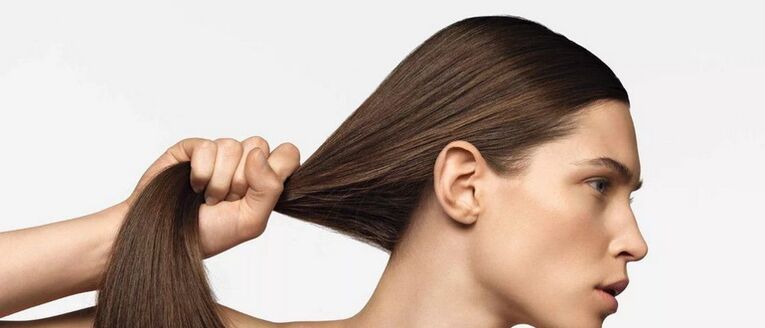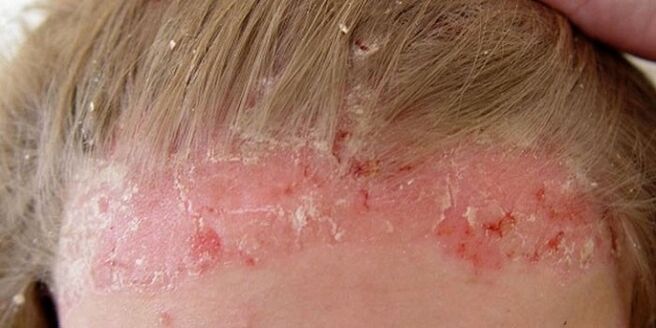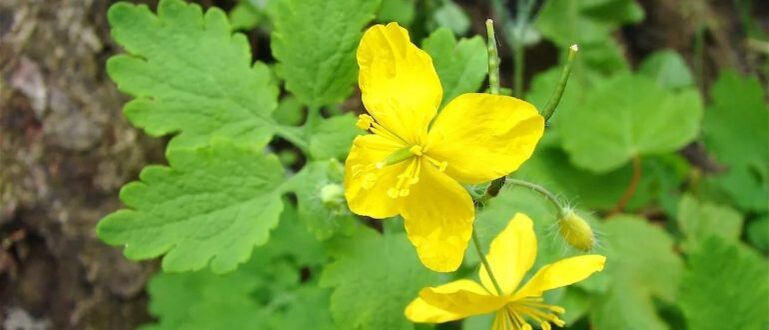Psoriasis on the head significantly reduces the quality of human life and requires a lot of effort and money for treatment. Constant struggle with the symptoms of psoriasis and the feeling that you are not like everyone else create a special psychological problem. This burden is especially heavy for young people who do not yet have a family. After all, people around you often perceive peeling on the head due to lice or think that the person is unclean. In fact, scaly lichens are not contagious and mostly occur as an inherited disease.
Causes
Scalp psoriasis occurs in children and adults. Its appearance, like the current one, is unpredictable. Scientists still do not understand why and why psoriatic rash appears on the human body and affects the scalp. They were able to establish that the appearance of psoriasis on the head and other parts of the body is preceded by a violation of the functions of the epidermis. This happens on the skin after exposure to an external irritant, for example, after using a poor quality shampoo or body gel.
It later became known that many factors contribute to the development of psoriasis, for example:
- improper diet;
- alcohol abuse;
- infectious skin diseases;
- general intoxication of the body;
- hormonal imbalance;
- endocrine disorders;
- weakening of immunity;
- allergic reactions.
This is not a complete list of what can affect the severity of scalp disease.

Psoriatic elements on the scalp occur, as in other localizations, in the upper layer of the epidermis, so they rarely interfere with the growth of individual hairs and cause their loss.
If you look, then all these and other, unnamed, causal factors have one thing in common - the ability to negatively affect metabolic processes in the skin. But this is one of the main reasons that causes abnormal proliferation of epidermal cells.
Symptoms of different types of disease
The following forms of psoriasis can occur on the head:
- Vulgar - another name for plaque psoriasis, is diagnosed in 90% of cases. It is characterized by the appearance of small papules and red spots on the scalp. Their surface is covered with dry silver scales that are easily removed with nails. The elements of the rash gradually increase, then merge into one and represent islets with a scaly gray surface.
- Pustular - exudative psoriasis, which is considered the most serious form of the disease, is manifested by small blisters with yellow or transparent contents. The skin underneath is swollen and hot. If left untreated, it is possible that ulcers caused by open blisters can become infected with a bacterial infection.
- In the form of drops - it develops in the background of streptococcal infection. The elements of the rash are teardrop-shaped and tend to increase.
What does psoriasis on the head look like in different stages
The initial stage of psoriasis on the head usually has symptoms similar to other dermatoses (there are coincidences with the usual dandruff, seborrheic dermatitis, etc. ). Therefore, only a specialist can correctly diagnose the disease in order to subsequently select an effective course of treatment.
At each stage of the development of psoriasis on the scalp, the following pathological changes are observed:
- A small papular itchy rash appears. Its elements are rounded and red or pink. At this stage, a characteristic feature of psoriatic eruptions is the formation of silvery scales on their surface that flake off when combed. The inflammatory process is absent, so patients with psoriasis are irritated only by itching and slight peeling of the skin.
- In the second stage of psoriasis, which is called progressive in medicine, the papules, enlarging, merge into individual islets and cover most of the scalp. Itchy skin intensifies, leading to itching and inflammation. In the absence of proper treatment, the infection enters the skin through scratching and causes the appearance of purulent pustules and yellow crusts under the hair.
- In the stationary phase, when the drugs used give the desired effect, the psoriatic plaques stop growing and the inflammation subsides. Due to the peeling of the whitish layer from the surface of the plaques, a lot of dandruff is noticed in the hair, the itching becomes less intense.
- After a while, the plaques on the scalp lighten, some disappear without a trace, the itching stops. The skin regains its elasticity. This is what psoriasis looks like in remission.

If psoriasis cannot be stopped in the progression phase, the scalp thickens, causing easy injury. Psoriatic plaques do not stop growing due to the appearance of new papules. When combing, huge scales of dead skin are removed from their surface, which cannot be completely combed from the hair.
Localization of skin diseases
If psoriatic plaques have formed on the scalp and have affected the entire scalp, then over time they can spread beyond the area of hair growth to the smooth skin of the forehead, to affect the area of the temples. Psoriasis can occur on the back of the head and upper neck, on the skin behind the ears and on their lobes. This form of localization of the disease is called "psoriatic crown".
Diagnostic characteristics
To diagnose the initial stage of psoriasis, it is not enough for a dermatologist to examine the scalp for the presence of small papules or itchy psoriatic plaques. Such elements of the rash are characteristic of other diseases, therefore, in addition to examination and interviewing the patient, a differential diagnosis is mandatory.
This type of examination makes it possible to distinguish psoriasis on the scalp from other dermatoses, which are also a favorite place of localization of the scalp. It is relevant to mention here:
- seborrhea - it is dandruff, a consequence of improper functioning of the sebaceous glands;
- rosacea - is characterized by the appearance of papules and pustules on red edematous skin, as in psoriasis;
- pityriasis versicolor - affects hair follicles, causes papules around the hairs.
When diagnosing psoriasis, the symptoms of the phenomenon, united by the name "psoriasis triad", are also taken into account. It includes three symptomatic phenomena:
- Stearin stain - when a papule or psoriatic plaque is scraped off, its surface becomes white, the scales separate.
- Terminal film - the surface of the papule after removal of the scales becomes pink and shiny.
- Spotting - occurs after scraping and removing the scales from one papule or psoriatic plaque.
In the process of diagnosis, the presence of the Kebner phenomenon is also taken into account, when a psoriatic element is formed in the affected area about 15-20 days after the skin injury. The symptom is characteristic of the progressive stage of psoriasis.
How to get rid of psoriasis on the head
The doctor develops an effective psoriasis treatment plan taking into account the general health condition of the patient, the form of the disease and the severity of its course.
The general treatment regimen includes:
- use of drugs for external and internal (sometimes) purposes;
- adherence to dietary rules;
- physiotherapy sessions;
- preventive hair care.
Scalp psoriasis is not dangerous, except for the pustular form of the disease, so some of the procedures prescribed by a doctor can be performed at home.
Which medications from the pharmacy help
Preparations for the treatment of scalp psoriasis are prescribed taking into account the stage of development of the disease:
- Progressive phase. Prescribe daily head washing with a special zinc shampoo, after which a therapeutic lotion or salicylic ointment is applied to the scalp twice a day. Means relieve itching, inflammation, help exfoliate dead epidermal cells, strengthen blood vessels of the skin.
- Stationary stage. Within 2-3 weeks, 5% lactic or salicylic acid is used to treat psoriatic plaques. The solutions soften the stratum corneum and promote its exfoliation, while helping other drugs to penetrate the affected epidermis. Among them, naphthalene-based cream improves local circulation, softens the skin and relieves inflammation. Non-hormonal ointments for psoriasis, which contain a synthetic analogue of vitamin D3, which stops the process of division of epidermal cells, contribute to their normal maturation.
- The symptom relief phase (regression phase) is used to treat the scalp with ointments, shampoos and ointments based on spruce or birch tar. The action of these drugs is aimed at improving metabolic processes and blood microcirculation in the scalp. Purified tar has anti-inflammatory, absorbent, antipruritic and exfoliating effects.
In addition to medical treatment, people with psoriasis on the scalp are well helped by homeopathic remedies in the period when the symptoms of the disease are alleviating. For example, made on the basis of such substances:
- lanolin (animal wax), which softens the stratum corneum;
- berberine - relieves inflammation;
- hollyhock mahogany extract - prevents the growth of immature epidermal cells and peeling.
In severe scalp psoriasis, patients are prescribed hormonal tablets, magnesium sulfate cleansing drops, sodium thiosulfate, and immunomodulatory drugs to alleviate the inflammation.
How to cure scalp psoriasis folk remedies
Masks prepared on the basis of medicinal herbs, liquid mixtures and decoctions for shampooing will help remove psoriatic plaques from the skin.
Hormonal ointment with celandine
Ingredients:
- freshly harvested (preferably) plant celandine - 1 tbsp. l. ;
- purified fat - 100 g.
Cooking method: mix the ingredients, mix well, leave for 3 days in a dark, warm place to soak.

Result: the product softens the stratum corneum of the scalp, eliminates itching and peeling, relieves inflammation.
How to use: apply the ointment in a thin layer on the plaques for no longer than 5 days in a row, because the composition contains a hormonal component that causes addiction.
Mustard mask for scalp psoriasis
Ingredients:
- mustard powder - 2 tbsp. l. ;
- hot water - 2 tbsp. l. ;
- vegetable oil - 2 tbsp. l. ;
- chicken egg yolks - 1 pc. ;
- sugar - 2 tsp
Method of cooking: add sugar mixed with mustard powder, butter and water to the egg yolk while beating.
How to use: apply the psoriasis mixture on the scalp, rub, put a cellophane cap on top, warm the head with a towel. The procedure should take at least 15 minutes. The skin will initially itch, and then it will start to burn. After the mask, the head is washed with lukewarm water with tar shampoo. Repeat the procedure every 2-3 days while the exacerbation lasts.
The result: the mask reduces itching, causes blood flow in the scalp, improves the local metabolic process and helps to soften and exfoliate the stratum corneum.
Decoction for rinsing hair after washing
Ingredients:
- amaranth seeds - 2 tsp;
- amaranth leaves - 1 tsp;
- boiling water - 750 ml.
How to cook: put the seeds in an enamel bowl, pour boiling water, cook for 5 minutes, add the leaves of the plant, put on heat for 30 minutes. Strain.
How to use: wash your hair with medical shampoos after washing.
The result: hair with psoriasis is easier to comb, it becomes soft and silky. In addition, the soup relieves inflammation, strengthens local immunity.
Diet rules
When treating psoriasis on the head, it is important to include in the menu foods that are a source of polyunsaturated fatty acids (mackerel, sardines, herring, venison, flax seeds, spinach). You should also eat cereals and cereal soups (buckwheat, oatmeal, rice), vegetable stews (beets, cabbage, potatoes), fresh berries and fruits, juices, herbal teas, dairy products.
It is recommended to cook food by cooking, baking and stewing. It is better to eat little by little, but 5-6 times a day. Too salty, spicy, smoked and fried foods, as well as sweets and alcohol are forbidden.
How is psoriasis on the head treated with physiotherapy?
Such an effective treatment as physiotherapy for psoriasis is prescribed in all stages of the disease, except in case of worsening.
Applied methods:
- Electrosleep - improves the psychological state of a person.
- PUVA therapy - relieves inflammation, improves the condition of the scalp.
- Phototherapy - normalizes metabolic processes in the skin, helps to prolong remission.
- Physiotherapy sessions give the desired result only with regular and correct procedures.
Hair care
When treating scalp psoriasis, it is recommended to use cosmetic detergents and hair masks with therapeutic action:
- Shampoos with birch and spruce tar.
- Medicinal oils for use in the form of masks (burdock, castor, amaranth, stone, naphthalene, currant, sesame).
With psoriasis, the head can be washed daily, the main thing is not to damage the skin until it bleeds when washed.
Lifestyle correction
Since psoriasis is often aggravated by stress, good mood helps to fight its manifestations on the head, which come every day only in people who lead an active and healthy lifestyle.
A healthy night's sleep is a guarantee of a good mood, so after a hard day you can take a tincture of peony or lemon balm at night.
Also, psoriasis in the area of the head is afraid of proper nutrition, so the preparation of a therapeutic diet should be taken seriously. You can consult a dietitian for this purpose.
The course of psoriasis in childhood and the characteristics of therapy
Scalp psoriasis in children proceeds in the same way as in adults, with exacerbations and remissions. For the treatment of psoriatic papules and plaques on the child's head, the doctor selects medications taking into account the age of the young patient and the presence of concomitant dermatological diseases. The initial phase of the pathology is easier to treat, so all procedures recommended by the doctor are performed at home.
In case the psoriatic elements occupy most of the head, then the doctors suggest the parents to hospitalize the child. Inpatient treatment is carried out:
- calcium gluconate - relieves itching, swelling, inflammation;
- vitamins A, E, D and group B - strengthen general and local immunity;
- with restless night's sleep a sleeping pill is prescribed.
During the treatment period, you should take care of your child's painful scalp with the help of the means prescribed by your doctor.
Can psoriasis be permanently cured?
So far, there is no such drug that would completely cure a person of psoriasis. The most effective that the pharmaceutical can offer to the patient to temporarily get rid of psoriatic rash are drugs in different dosage forms with anti-inflammatory, antipruritic and exfoliating action. Vitamin D3, which slows down pathological changes on the skin, as well as through physiotherapeutic procedures, has shown its effectiveness.























